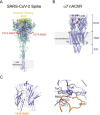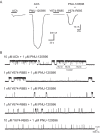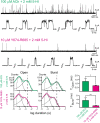A Functional Interaction Between Y674-R685 Region of the SARS-CoV-2 Spike Protein and the Human α7 Nicotinic Receptor
- PMID: 35859025
- PMCID: PMC9299415
- DOI: 10.1007/s12035-022-02947-8
A Functional Interaction Between Y674-R685 Region of the SARS-CoV-2 Spike Protein and the Human α7 Nicotinic Receptor
Abstract
The α7 nicotinic acetylcholine receptor (nAChR) is present in neuronal and non-neuronal cells and has anti-inflammatory actions. Molecular dynamics simulations suggested that α7 nAChR interacts with a region of the SARS-CoV-2 spike protein (S), and a potential contribution of nAChRs to COVID-19 pathophysiology has been proposed. We applied whole-cell and single-channel recordings to determine whether a peptide corresponding to the Y674-R685 region of the S protein can directly affect α7 nAChR function. The S fragment exerts a dual effect on α7. It activates α7 nAChRs in the presence of positive allosteric modulators, in line with our previous molecular dynamics simulations showing favourable binding of this accessible region of the S protein to the nAChR agonist binding site. The S fragment also exerts a negative modulation of α7, which is evidenced by a profound concentration-dependent decrease in the durations of openings and activation episodes of potentiated channels and in the amplitude of macroscopic responses elicited by ACh. Our study identifies a potential functional interaction between α7 nAChR and a region of the S protein, thus providing molecular foundations for further exploring the involvement of nAChRs in COVID-19 pathophysiology.
Keywords: Neurotransmitter receptors; Nicotinic receptor; Patch-clamp; SARS-CoV-2 spike protein; Single-channel recordings.
© 2022. The Author(s), under exclusive licence to Springer Science+Business Media, LLC, part of Springer Nature.
Conflict of interest statement
The authors declare no competing interests.
Figures







Similar articles
-
A potential interaction between the SARS-CoV-2 spike protein and nicotinic acetylcholine receptors.Biophys J. 2021 Mar 16;120(6):983-993. doi: 10.1016/j.bpj.2021.01.037. Epub 2021 Feb 18. Biophys J. 2021. PMID: 33609494 Free PMC article.
-
Simulations support the interaction of the SARS-CoV-2 spike protein with nicotinic acetylcholine receptors.bioRxiv [Preprint]. 2020 Sep 14:2020.07.16.206680. doi: 10.1101/2020.07.16.206680. bioRxiv. 2020. Update in: Biophys J. 2021 Mar 16;120(6):983-993. doi: 10.1016/j.bpj.2021.01.037. PMID: 32743575 Free PMC article. Updated. Preprint.
-
SARS-CoV-2 spike ectodomain targets α7 nicotinic acetylcholine receptors.J Biol Chem. 2023 May;299(5):104707. doi: 10.1016/j.jbc.2023.104707. Epub 2023 Apr 13. J Biol Chem. 2023. PMID: 37061001 Free PMC article.
-
Advances in the discovery of novel positive allosteric modulators of the alpha7 nicotinic acetylcholine receptor.Recent Pat CNS Drug Discov. 2007 Jun;2(2):99-106. doi: 10.2174/157488907780832751. Recent Pat CNS Drug Discov. 2007. PMID: 18221220 Review.
-
Molecular function of α7 nicotinic receptors as drug targets.J Physiol. 2018 May 15;596(10):1847-1861. doi: 10.1113/JP275101. Epub 2017 Nov 29. J Physiol. 2018. PMID: 29131336 Free PMC article. Review.
Cited by
-
Cholinergic Polarization of Human Macrophages.Int J Mol Sci. 2023 Oct 29;24(21):15732. doi: 10.3390/ijms242115732. Int J Mol Sci. 2023. PMID: 37958716 Free PMC article. Review.
-
α7- and α9-Containing Nicotinic Acetylcholine Receptors in the Functioning of Immune System and in Pain.Int J Mol Sci. 2023 Mar 30;24(7):6524. doi: 10.3390/ijms24076524. Int J Mol Sci. 2023. PMID: 37047495 Free PMC article. Review.
-
Allosteric modulation by the fatty acid site in the glycosylated SARS-CoV-2 spike.Elife. 2025 Apr 10;13:RP97313. doi: 10.7554/eLife.97313. Elife. 2025. PMID: 40208235 Free PMC article.
-
Cardiovascular autonomic dysfunction in "Long COVID": pathophysiology, heart rate variability, and inflammatory markers.Front Cardiovasc Med. 2023 Sep 1;10:1256512. doi: 10.3389/fcvm.2023.1256512. eCollection 2023. Front Cardiovasc Med. 2023. PMID: 37719983 Free PMC article. Review.
-
SARS-CoV-2-Related Olfactory Dysfunction: Autopsy Findings, Histopathology, and Evaluation of Viral RNA and ACE2 Expression in Olfactory Bulbs.Biomedicines. 2024 Apr 9;12(4):830. doi: 10.3390/biomedicines12040830. Biomedicines. 2024. PMID: 38672185 Free PMC article.
References
MeSH terms
Substances
Grants and funding
- PGI 24/B298/Universidad Nacional del Sur
- EP/M022609/1/Engineering and Physical Sciences Research Council
- BB/R016445/1/BB_/Biotechnology and Biological Sciences Research Council/United Kingdom
- PICT 2017 1170/Agencia Nacional de Promoción Científica y Tecnológica
- BB/L01386X/1/BB_/Biotechnology and Biological Sciences Research Council/United Kingdom
LinkOut - more resources
Full Text Sources
Medical
Miscellaneous

